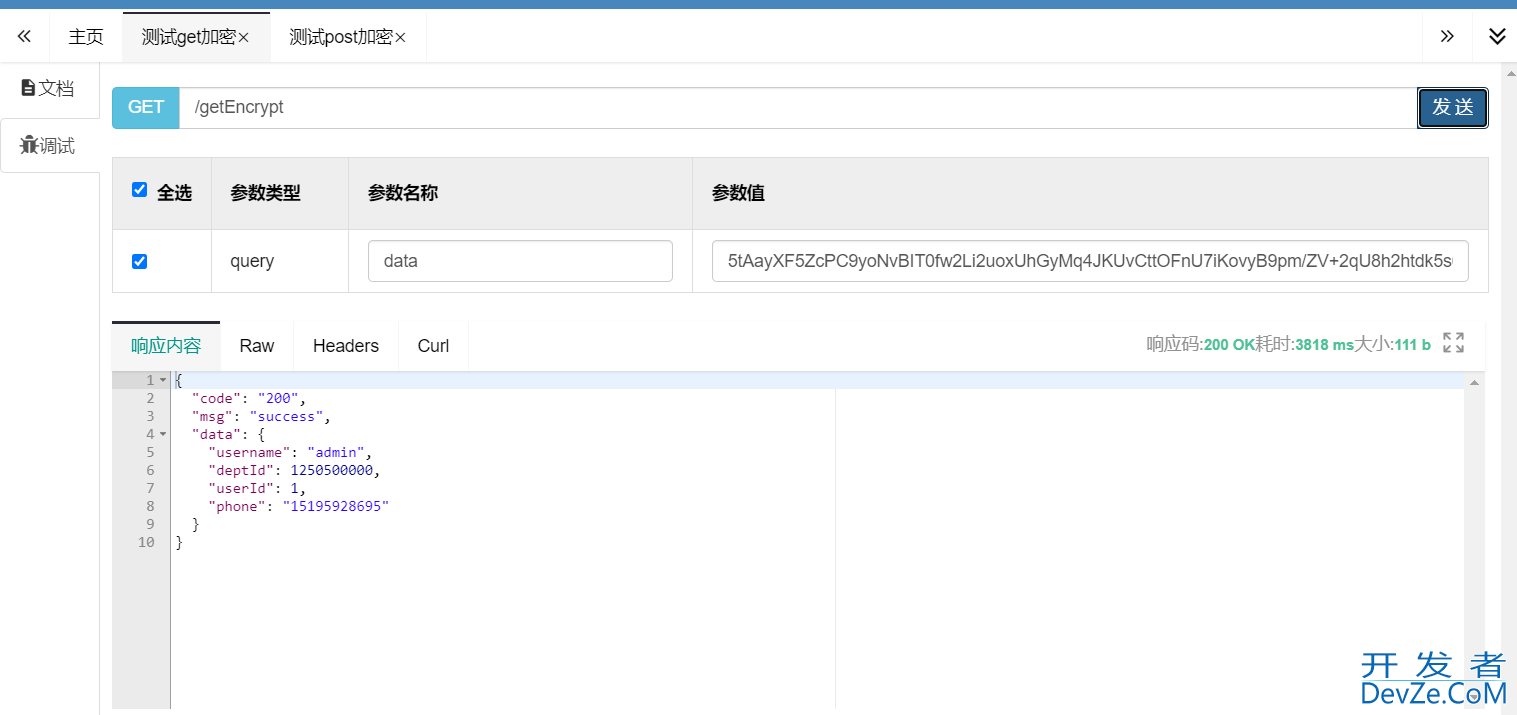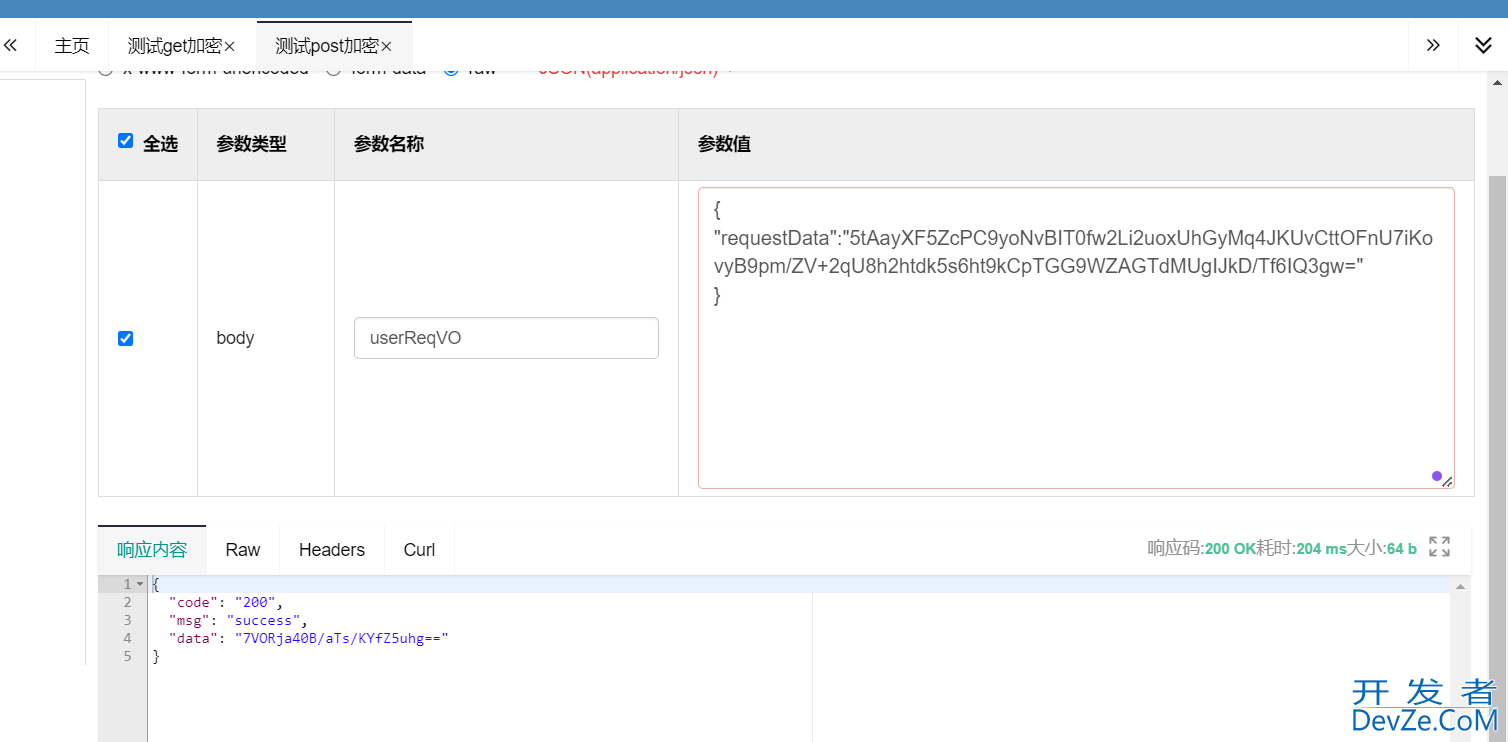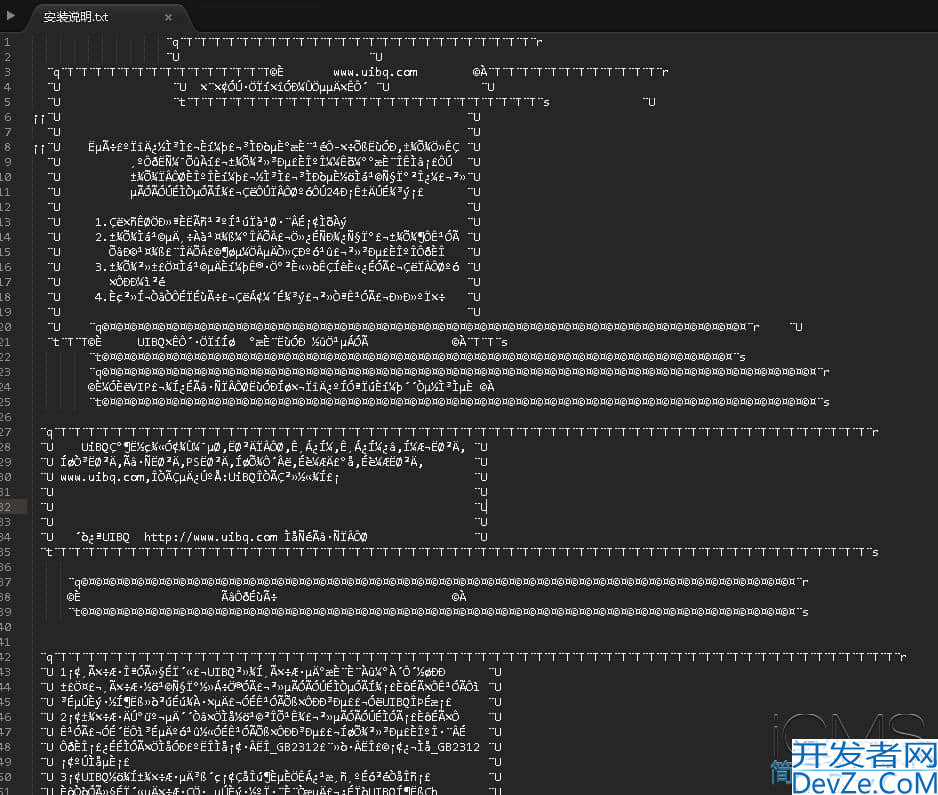SpringBoot请求参数加密、响应参数解密的实现
目录
- 1.说明
- 2.准备工作
- 3.代码实现
- 1.定义两个注解
- 2.加密解密实现核心代码
- 3.统一返回结果
- 4.加密工具类
- 5.请求流支持多次获取
- 4.测试
1.说明
在项目开发工程中,有的项目可能对参数安全要求比较高,在整个http数据传输的过程中都需要对请求参数、响应参数进行加密,也就是说整个请求响应的过程都是加密处理的,不在浏览器上暴露请求参数、响应参数的真实数据。
补充:也可以用于单点登录,在请求参数中添加时间戳,后台解析请求参数对时间戳进行校验,比如当前时间和请求参数中的时间戳相差多少秒、分钟才能进行放行,返回token。这样做的好处在于请求js端每次加密之后的密文都是变化的,也能够避免携带相同的报文可以重复的登录。
2.准备工作
1.引入依赖, 创建SpringBoot工程
<dependencies> <dependency> <groupId>org.springframework.boot</groupId> <artifactId>spring-boot-starter-web</artifactId> </dependency> <dependency> <groupId>org.projectlohttp://www.devze.commbok</groupId> <artifactId>lombok</artifactId> </dependency> <dependency> <groupId>cn.hutool</groupId> <artifactId>hutool-all</artifactId> </dependency> <dependency> <groupId>commons-io</groupId> <artifactId>commons-io</artifactId> <version>2.11.0</version> </dependency> <dependency> <groupId>junit</groupId> <artifactId>junit</artifactId> </dependency> <dependency> <groupId>commons-codec</groupId> <artifactId>commons-codec</artifactId> </dependency> <dependency> <groupId>org.springframework.boot</groupId> <artifactId>spring-boot-starter-aop</artifactId> </dependency> <!--swagger--> <dependency> <groupId>io.springfox</groupId> <artifactId>springfox-swagger2</artifactId> <version>3.0.0</version> </dependency> <dependency> <groupId>io.springfox</groupId> <artifactId>springfox-swagger-ui</artifactId> <version>3.0.0</version> </dependency> <dependency> <groupId>io.swagger</groupId> <artifactId>swagger-annotations</artifactId> <version>1.5.22</version> </dependency> <dependency> <groupId>com.github.xiaoymin</groupId> <artifactId>swagger-bootstrap-ui</artifactId> <version>1.8.7</version> </dependency> <dependency> <groupId>org.apache.commons</groupId> <artifactId>commons-lang3</artifactId> </dependency> </dependencies>
3.代码实现
1.定义两个注解
/**
* @description: : 请求参数解密
*/
@Target(ElementType.METHOD)
@Retention(RetentionPolicy.RUNTIME)
@Documented
public @interface DecryptionAnnotation {
}
/**
* @description: 响应参数加密
*/
@Target(ElementType.METHOD)
@Retention(RetentionPolicy.RUNTIME)
@Documented
public @interface EncryptionAnnotation {
}
2.加密解密实现核心代码
DecryptRequestBodyAdvice:请求参数解密,针对post请求
package com.llp.crypto.advice;
import cn.hutool.json.JSONUtil;
import com.llp.crypto.annotation.DecryptionAnnotation;
import com.llp.crypto.utils.AESUtil;
import lombok.SneakyThrows;
import lombok.extern.slf4j.Slf4j;
import org.apache.commons.io.IOUtils;
import org.springframework.core.MethodParameter;
import org.springframework.http.HttpHeaders;
import org.springframework.http.HttpInputMessage;
import org.springframework.http.converter.HttpMessageConverter;
import org.springframework.web.bind.annotation.ControllerAdvice;
import org.springframework.web.bind.annotation.PostMapping;
import org.springframework.web.servlet.mvc.method.annotation.RequestBodyAdvice;
import Java.io.IOException;
import java.io.InputStream;
import java.lang.reflect.Type;
/**
* @description: 请求参数解密,针对post请求
*/
@Slf4j
@ControllerAdvice
public class DecryptRequestBodyAdvice implements RequestBodyAdvice {
/**
* 方法上有DecryptionAnnotation注解的,进入此拦截器
*
* @param methodParameter 方法参数对象
* @param targetType 参数的类型
* @param converterType 消息转换器
* @return true,进入,false,跳过
*/
@Override
public boolean supports(MethodParameter methodParameter, Type targetType, Class<? extends HttpMessageConverter<?>> converterType) {
return methodParameter.hasMethodAnnotation(DecryptionAnnotation.class);
}
@Override
public HttpInputMessage beforeBodyRead(HttpInputMessage inputMessage, MethodParameter parameter, Type targetType, Class<? extends HttpMessageConverter<?>> converterType) throws IOException {
try {
return new MyHttpInputMessage(inputMessage, parameter);
} catch (Exception e) {
throw new RuntimeException(e);
}
}
/**
* 转换之后,执行此方法,解密,赋值
*
* @param body spring解析完的参数
* @param inputMessage 输入参数
* @param parameter 参数对象
* @param targetType 参数类型
* @param converterType 消息转换类型
* @return 真实的参数
*/
@SneakyThrows
@Override
public Object afterBodyRead(Object body, HttpInputMessage inputMessage, MethodParameter parameter, Type targetType, Class<? extends HttpMessageConverter<?>> converterType) {
log.info("解密后的请求报文:{}", body);
return body;
}
/**
* 如果body为空,转为空对象
*
* @param body spring解析完的参数
* @param inputMessage 输入参数
* @param parameter 参数对象
* @param targetType 参数类型
* @param converterType 消息转换类型
* @return 真实的参数
*/
@Override
public Object handleEmptyBody(Object body, HttpInputMessage inputMessage, MethodParameter parameter, Type targetType, Class<? extends HttpMessageConverter<?>> converterType) {
return body;
}
class MyHttpInputMessage implements HttpInputMessage {
private HttpHeaders headers;
private InputStream body;
private MethodParameter parameter;
public MyHttpInputMessage(HttpInputMessage inputMessage, MethodParameter parameter) throws Exception {
this.headers = inputMessage.getHeaders();
//只对post请求进行加密
if (parameter.hasMethodAnnotation(PostMapping.class)) {
/*
*请求报文示例:
* {
* "requestData":"JF7kvl9Wd/vgdmAS8JijsQ=="
* }
*/
js String decrypt = AESUtil.decrypt(eASPData(IOUtils.toString(inputMessage.getBody(), "UTF-8")));
log.info("解密后的请求参数:{}", decrypt);
this.body = IOUtils.toInputStream(decrypt, "UTF-8");
} else {
this.body = inputMessage.getBody();
}
}
@Override
public InputStream getBody() throws IOException {
return body;
}
@Override
public HttpHeaders getHeaders() {
return headers;
}
}
public String easpData(String requestData) {
if (requestData != null && !requestData.equals("")) {
String start = "requestData";
if (requestData.contains(start)) {
return JSONUtil.parseobj(requestData).getStr(start);
} else {
throw new RuntimeException("参数【requestData】缺失异常!");
}
}
return "";
}
}
GetDeleteDecryptAspect:针对get、delete请求参数进行解密
@Aspect
//值越小优先级越高
@Order(-1)
@Component
@Slf4j
public class GetDeleteDecryptAspect {
/**
* 对get、delete方法进行解密
* @param point
* @return
* @throws Throwable
*/
@Around("@annotation(com.llp.crypto.annotation.DecryptionAnnotation) && " + "(@annotation(org.springframework.web.bind.annotation.GetMapping) || @annotation(org.springframework.web.bind.annotation.DeleteMapping))")
public Object aroundMethod(ProceedingJoinPoint point) throws Throwable {
MethodSignature signature = (MethodSignature) point.getSignature();
Method method = signature.getMethod();
// 获取到请求的参数列表
Object[] args = point.getArgs();
// 判断方法请求参数是否需要解密
if (method.isAnnotationPresent(DecryptionAnnotation.class)) {
try {
this.decrypt(args, point);
log.info("返回解密结果=" + args);
} catch (Exception e) {
e.printStackTrace();
log.error("对方法method :【" + method.getName() + "】入参数据进行解密出现异常:" + e.getMessage());
}
}
// 执行将解密的结果交给控制器进行处理,并返回处理结果
return point.proceed(args);
}
/**
* 前端对请求参数进行加密,最终将这个加密的字符串已 localhost:48080?data=xxx这样的方式进行传递
* 后端后去到 data的数据进行解密最终得到解密后的数据
* @param args
* @param point
* @throws Exception
*/
// 解密方法
@SuppressWarnings("unchecked")
public void decrypt(Object[] args, ProceedingJoinPoint point) throws Exception {
ServletRequestAttributes sc = (ServletRequestAttributes) RequestContextHolder.getRequestAttributes();
HttpServletRequest request = sc.getRequest();
String data = request.getParameter("data");
log.info("data: " + data);
// 将密文解密为JSON字符串
Class<?> aClass = args[0].getClass();
log.info("数据类型:{}",aClass.getClass());
if (StringUtils.isNotEmpty(data)) {
// 将JSON字符串转换为Map集合,并替换原本的参数
args[0] = JSONUtil.toBean(AESUtil.decrypt(data), args[0].getClass());
}
}
}
EncryptResponseBodyAdvice:响应参数解密,针对统一返回结果类的装配
/**
* @description: 响应加密
*/
@Slf4j
@ControllerAdvice
public class EncryptResponseBodyAdvice implements ResponseBodyAdvice {
@Override
public boolean supports(MethodParameter methodParameter, Class aClass) {
return methodParameter.hasMethodAnnotation(EncryptionAnnotation.class);
}
@Override
public Object beforeBodyWrite(Object body, MethodParameter methodParameter, MediaType mediaType, Class aClass, ServerHttpRequest serverHttpRequest, ServerHttpResponse serverHttpResponse) {
log.info("对方法method :【" + methodParameter.getMethod().getName() + "】返回数据进行加密");
// 只针对回参类型为CommonResult的对象,进行加密
if (body instanceof CommonResult) {
CommonResult commonResult = (CommonResult) body;
Object data = commonResult.getData();
if (Objects.nonNull(data)) {
// 将响应结果转换为json格式
String result = JSONUtil.toJsonStr(data);
log.info("返回结果:{}", result);
try {
String encrypt = AESUtil.encrypt(result);
commonResult.setData(encrypt);
log.info("返回结果加密=" + commonResult);
} catch (Exception e) {
log.error("对方法method :【" + methodParameter.getMethod().getName() + "】返回数据进行解密出现异常:" + e.getMessage());
}
return commonResult;
}
}
return body;
}
}
3.统一返回结果
@Data
public class CommonResult<T> {
private String code;
private String msg;
private T data;
public CommonResult() {
}
public CommonResult(T data) {
this.data = data;
}
/**
* 表示成功的Result,不携带返回数据
*
* @return
*/
public static CommonResult success() {
CommonResult result = new CommonResult();
result.setCode("200");
result.setMsg("success");
return result;
}
/**
* 便是成功的Result,携带返回数据
* 如果需要在static方法使用泛型,需要在static后指定泛型表示 static<T>
*
* @param data
* @return
*/
public static <T> CommonResult<T> success(T data) {
CommonResult<T> result = new CommonResult<>(data);
result.setCode("200");
result.setMsg("success");
return result;
}
/**
* 失败不携带数据
* 将错误的code、msg作为形参,灵活传入
*
* @param code
* @param msg
* @return
*/
public static CommonResult error(String code, String msg) {
CommonResult result = new CommonResult();
result.setCode(code);
result.setMsg(msg);
return result;
}
/**
* 失败携带数据
* 将错误的code、msg、data作为形参,灵活传入
* @param code
* @param msg
* @param data
* @param <T>
* @return
*/
public static <T> CommonResult<T> error(String code, String msg, T data) {
CommonResult<T> result = new CommonResult<>(data);
result.setCode(code);
result.setMsg(msg);
return result;
}
}
4.加密工具类
public class AESUtil {
// 加解密方式
private static final String AES_ALGORITHM = "AES/ECB/PKCS5Padding";
// 与前端统一好KEY
private static final String KEY = "abcdsxyzhkj12345";
// 获取 cipher
private static Cipher getCipher(byte[] key, int model) throws Exception {
SecretKeySpec secretKeySpec = new SecretKeySpec(KEY.getBytes(), "AES");
Cipher cipher = Cipher.getInstance(AES_ALGORITHM);
cipher.init(model, secretKeySpec);
return cipher;
}
// AES加密
public static String encrypt(String data) throws Exception {
Cipher cipher = getCipher(KEY.getBytes(), Cipher.ENCRYPT_MODE);
return Base64.getEncoder().encodeToString(cipher.doFinal(data.getBytes("UTF-8")));
}
// AES解密
public static String decrypt(String data) throws Exception {
Cipher cipher = getCipher(KEY.getBytes(), Cipher.DECRYPT_MODE);
return new String(cipher.doFinal(Base64.getDecoder().decode(data.getBytes("UTF-8"))),"UTF-8");
}
public static byte[] decryptUrl(String url) throws Exception {
Cipher cipher = getCipher(KEY.getBytes(), Cipher.DECRYPT_MODE);
return cipher.doFinal(Base64.getDecoder().decode(url.replaceAll(" +", "+")));
}
// AES解密mysql AES_ENCRYPT函数加密密文
public static String aesDecryptMySQL(String key, String content){
try {
SecretKey secretKey = generateMySQLAESKey(key,"ASCII");
Cipher cipher = Cipher.getInstance("AES");
cipher.init(Cipher.DECRYPT_MODE, secretKey);
byte[] cleartext = Hex.decodeHex(content.toCharArray());
byte[] ciphertextBytes = cipher.doFinal(cleartext);
return new String(ciphertextBytes, StandardCharsets.UTF_8);
} catch (Exception e) {
e.printStackTrace();
}
return null;
}
//加密
public static String aesEncryptMySQL(String key2, String content) {
try {
SecretKey key = generateMySQLAESKey(key2,"ASCII");
Cipher cipher = Cipher.getInstance("AES");
cipher.init(Cipher.ENCRYPT_MODE, key);
byte[] cleartext = content.getBytes("UTF-8");
byte[] ciphertextBytes = cipher.doFinal(cleartext);
return new String(Hex.encodeHex(ciphertextBytes));
} catch (Exception e) {
e.printStackTrace();
}
return null;
}
public static SecretKeySpec generateMySQLAESKey(final String key, final String encoding) {
try {
final byte[] finalKey = new byte[16];
int i = 0;
for(byte b : key.getBytes(encoding)) {
finalKey[i++%16] ^= b;
}
return new SecretKeySpec(finalKey, "AES");
} catch(UnsupportedEncodingException e) {
throw new RuntimeException(e);
}
}
@Test
public void decodeTest() {
try {
String a = "{\"username\":\"admxCNzxDYin\",\"deptId\":\"1250500000\",\"userId\":\"1\",\"phone\":\"15195928695\"}";
String encrypt = AESUtil.encrypt(a);
System.out.println("加密后的字符串: "+encrypt);
System.out.println("解密后的字符串:" +AESUtil.decrypt(encrypt));
String str = "5tAayXF5ZcPC9yoNvbIT0fw2Li2uoxUhGyMq4JKUvCttOFnU7iKovyB9pm/ZV+2qU8h2htdk5s6ht9kCpTGG9WZAGTdMUgIJkD/Tf6IQ3gw=";
String decrypt = AESUtil.decrypt(IOUtils.toString(str.getBytes(), "UTF-8"));
System.out.println(decrypt);
} catch (Exception e) {
e.printStackTrace();
}
}
}
5.请求流支持多次获取
/**
* 请求流支持多次获取
*/
public class InputStreamHttpServletRequestWrapper extends HttpServletRequestWrapper {
/**
* 用于缓存输入流
*/
private ByteArrayOutputStream cachedBytes;
pub编程客栈lic InputStreamHttpServletRequestWrapper(HttpServletRequest request) {
super(request);
}
@Override
public ServletInputStream getInputStream() throws IOException {
if (cachedBytes == null) {
// 首次获取流时,将流放入 缓存输入流 中
cacheInputStream();
}
// 从 缓存输入流 中获取流并返回
return new CachedServletInputStream(cachedBytes.toByteArray());
}
@Override
public BufferedReader getReader() throws IOException {
return new BufferedReader(new InputStreamReader(getInputStream()));
}
/**
* 首次获取流时,将流放入 缓存输入流 中
*/
private void cacheInputStream() throws IOException {
// 缓存输入流以便多次读取。为了方便, 我使用 org.apache.commons IOUtils
cachedBytes = new ByteArrayOutputStream();
IOUtils.copy(super.getInputStream(), cachedBytes);
}
/**
* 读取缓存的请求正文的输入流
* <p>
* 用于根据 缓存输入流 创建一个可返回的
*/
public static class CachedServletInputStream extends ServletInputStream {
private final ByteArrayInputStream input;
public CachedServletInputStream(byte[] buf) {
// 从缓存的请求正文创建一个新的输入流
input = new ByteArrayInputStream(buf);
}
@Override
public boolean isFinished() {
return false;
}
@Override
public boolean isReady() {
return false;
}
@Override
public void setReadListener(ReadListener listener) {
}
@Override
public int read() throws IOException {
return input.read();
}
}
}
4.测试
1.测试类
@Slf4j
@RestController
@Api(tags = "测试加密解密")
public class TestController {
/**
* 请求示例:
* {
* "requestData":"5tAayXF5ZcPC9yoNvBIT0fw2Li2uoxUhGyMq4JKUvCttOFnU7iKovyB9pm/ZV+2qU8h2htdk5s6ht9kCpTGG9WZAGTdMUgIJkD/Tf6IQ3gw="
* }
*
* @return
*/
@PostMapping(value = "/postEncrypt")
@ApiOperation("测试post加密")
@EncryptionAnnotation
@DecryptionAnnotation
public CommonResult<String> postEncrypt(@RequestBody UserReqVO userReqVO) {
System.out.println("userReqVO: ============>" + userReqVO);
return CommonResult.success("成功");
}
@GetMapping(value = "/getEncrypt")
@ApiOperation("测试get加密")
@DecryptionAnnotation // requestBody 自动解密
public CommonResult<UserReqVO> getEncrypt(String data) {
log.info("解密后的数据:{}",data);
UserReqVO userReqVO = JSONUtil.toBean(data, UserReqVO.class);
//UserReqVO(username=admin, deptId=1250500000, userId=1, phone=15195928695)
log.info("用户信息:{}",userReqVO);
return CommonResult.success(userReqVO);
}
}
@ApiModel(description = "用户请求vo")
@Data
public class UserReqVO {
@ApiModelProperty(value = "用户名", required = true)
private String username;
@ApiModelProperty(value = "部门id",required = true)
private Long deptId;
@ApiModelProperty(value = "用户id",required = true)
private Long userId;
@ApiModelProperty(value = "电话号码",required = true)
private String phone;
}
测试结果


到此这篇关于SpringBoot请求参数加密、响应参数解密的实现的文章就介绍到这了,更多相关SpringBoot请求参数加密、响应参数解密内容请搜索编程客栈(www.devze.com)以前的文章或继续浏览下面的相关文章希望大家以后多多支持编程客栈(www.devze.com)!






 加载中,请稍侯......
加载中,请稍侯......
精彩评论